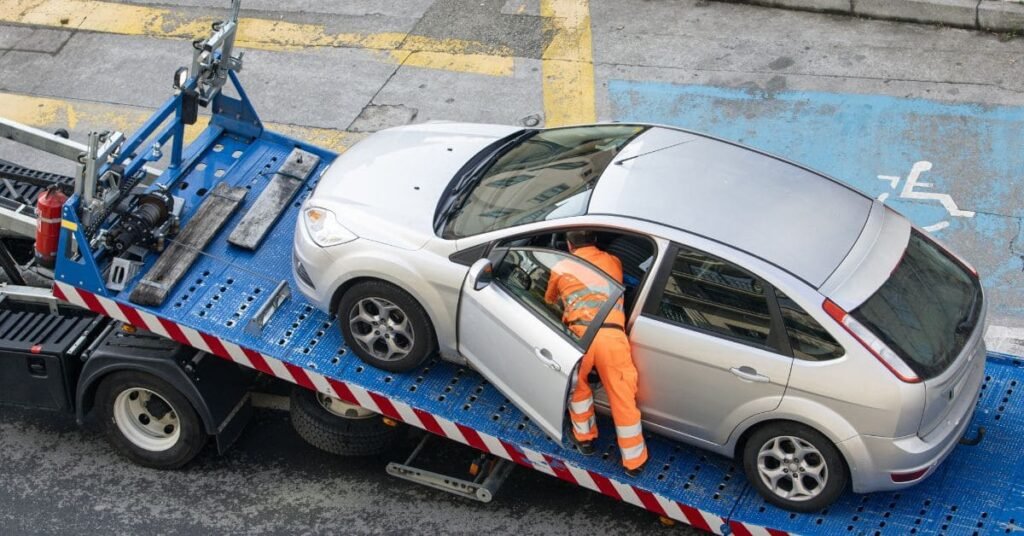A flatbed tow truck combines a conventional pickup chassis with a fixed, horizontal platform that is close to the ground. The long, flat bed can accommodate everything from compact sedans to oversized pickups and classic cars, with a hydraulic tipping device forming a ramp at the start of the loading process.
Since the entire vehicle rests over the axles during transport, the risk of bent frame parts or scratched tires is reduced in Ontario. Drivers appreciate the fact that nothing drags across the surface and that the usual start and stop bumps of wheel lifts are replaced by a single, gentle rise.
Flatbed tow trucks are the first choice for transporting all types of vehicles, from classic sports cars and motorcycles to regular cars that break down on the highway. Because the entire vehicle is on a flat platform, there is no risk of scratching the paintwork or bending the bodywork. This advantage comes into play especially when a car is already damaged or can no longer roll on its wheels.
Table of Contents
ToggleHow Does A Tow Truck With A Flatbed Work?
Transporting a vehicle with a flatbed tow truck is a straightforward process that involves four main steps:
1. Raising The Load Bed
Powerful hydraulic cylinders tilt the load bed outwards and downwards until it lies almost flat on the road surface. This low angle allows the driver of an operational vehicle to roll up the ramp or pull a non-operational vehicle into position using a winch.
2. Securing The Vehicle
Once the vehicle is on the platform, employees attach heavy straps or metal chains to strategic points on the chassis and pull them tight to prevent the load from wobbling.
3. Raising The Platform
The hydraulic controls are operated again to bring the tipping platform back to a vertical position so that the tires no longer touch the ground. At this stage, the raised vehicle is practically suspended in a steel basket.
4. Transporting The Vehicle
When everything is locked, the truck can roll into the workshop, the owner’s garage, or wherever the customer needs it.
Since all parts of the original suspension remain off the roadway, flatbed towing is routinely recommended when damage prevention is a priority.
Why Tow With A Flatbed Trailer?
Flatbed tow trucks have steadily gained popularity because they solve many problems that arise during vehicle recovery. Here are some of the reasons why so many roadside assistance professionals are now turning to flatbeds rather than any other vehicle.
1. Safe And Secure Transportation
The biggest advantage of a flatbed truck is safety for both the load and the driver. As the entire vehicle is on a flat surface and not being pulled by the wheels, vibrations, scratches, and stresses that lead to new damage are virtually eliminated. This approach is especially reassuring for cars with short tires or long spoilers, sleek sports sedans, vintage showpieces, and even motorcycles that would be wrecked under a dolly hitch.
2. Versatility For All Vehicle Types
The flat loading surface is suitable for almost any application, from compact sedans to heavy trucks and even classic motorcycles on their stands. Because the ramp rises low and the wheel lift mechanism then locks everything in place, battery jumps, scrapped cars, and diesel-powered ranch vans can all be carried out with the same device. With a second spare ramp at the rear, the driver can transport multiple loads during a single call, reducing the customer’s waiting time on the road.
3. Prevents Additional Damage
Traditional towing typically involves pulling a vehicle by the wheels or hooking it to a single point, which can put stress on drivetrains, tires, and suspensions. When a car is towed in neutral, the joints and belts have to keep turning long after these parts have given their all. A flatbed truck solves this problem by lifting the entire vehicle off the road and lashing it down at four corners. Since nothing is rolling except the tow truck itself, additional wear is virtually eliminated.
4. Ideal For Long-Distance Transportation
Moving a car a few streets away is never pleasant, but a local tow truck can usually handle the trip without incident. However, if you’re running the same job to the next county or across state lines, the mechanical hassle increases quickly.
A flatbed absorbs miles of bumps and speed bumps while keeping the wheels stationary and the sheet metal stable. Because the load slides onto a right-angled ramp and stays there, cyclical movements caused by friction, wind, and vibrations are reduced to an absolute minimum.
5. The Vehicle Does Not Need To Be Started
If the battery is flat or the engine is emitting clouds of smoke, opening the hood usually says the same thing: the car is not playing ball. Towing it with a chain or a wheel loader can still pull it a little way, but cables can break, axles can be bent, or gearshift linkages can become wedged.
With a flatbed, the broken, rusted, or flooded machine never has to twitch the pedal. The instructors attach a winch cable, pull the vehicle uphill, and secure the wheels while they are on the ground so that the person calling the towing service never has to turn the ignition again.
Advantages Of Using A Tow Truck For Roadside Assistance
When a car breaks down, waiting for the right tow truck can be just as frustrating as the breakdown itself. Choosing a tow truck that is appropriate for the situation will speed up the process and protect the damaged vehicle. For this reason, roadside assistance providers routinely favour flatbed vehicles in many consumer scenarios.
No Damage To Low Profile Vehicles
Flatbeds lift the entire vehicle onto a flat surface, so there is no contact between the wheels and the road. On low-profile sports cars, this technology protects the sensitive underbody from scratches or bending.
Transporting Cars That Are Not Ready To Drive
If an engine stalls, the steering locks, or the gearbox stalls, a flatbed slides directly under the vehicle. Thanks to the ramps, the crew can pull the vehicle on board with a winch without having to turn the wheels.
Less Risk Of Further Damage
With conventional hooks, the tires can spin while the jack drags the chassis on uneven asphalt. With a flatbed, this movement is stopped so that suspension parts, wheel bearings, and alignment remain within design tolerances.
Convenience For Drivers And Passengers
Because a flatbed lifts the entire vehicle off the ground, drivers can load and unload the vehicle much faster than with a wheel lift or hooklift. This quick and safe process reduces the time you and your vehicle spend on the side of the road, allowing you to drive on and continue your schedule with minimal delay.
Common Uses Of Flatbed Tow Trucks
1. Towing Motorcycles
Motorcycles are narrow, weigh little, and can almost tip over sideways, causing a lot of headaches for tow trucks. On a flatbed, tipping over is avoided altogether, and the crew has room to tighten wide straps to hold the motorcycle in place while rolling.
2. Transporting Classic And Luxury Cars
Shiny paintwork. At a muscle car meeting or a Bentley showroom, transportation must be carried out in such a way that not a single swirl is left on the paintwork. Damage from chains or cable hooks is easily possible, and a ramp leaves room for this. A low loader is, therefore, almost always the recommendation when someone asks how to transport high-quality goods without damage.
3. Accident And Breakdown Assistance
At the scene of an accident or serious engine failure, time is more than money; it’s the difference between a bent frame and a scrap yard. Flatbed trucks slide into the longer gear, enclose the axles, and lift them gently enough that residual stresses hardly spread. This quick, controlled removal allows the tow truck to take the vehicles straight to the workshops, where the technicians are trained to repair even the worst surprises that still roll through the door.
4. Transportation Of Heavy Equipment And Machinery
Professional towing fleets often use flatbed trucks to transport heavy machinery and industrial equipment. Since these vehicles can carry several tons, they are a flexible and reliable option for transporting excavators, generators, and similar oversized loads.
How To Choose The Right Flatbed Towing Service
When looking for a towing service in your area, choosing a towing company that has a reputation for quality work is crucial. The following guidelines can help you find the best towing service for your needs:
Look For A Reliable And Experienced Company
Opt for a provider with a solid history of safe, on-time removals. Experienced employees know how to secure and unload your machinery without damaging it.
Compare Prices
Estimates for towing jobs can vary widely, so get quotes from at least three providers. Opt for an affordable quote that states the costs upfront and doesn’t include any hidden fees.
Read Customer Reviews
Third-party feedback is invaluable. Check recent reviews and testimonials to ensure the company consistently provides the professional service it advertises.
Conclusion
Flatbed tow trucks offer a safe, versatile, and damage-free solution for transporting vehicles in Ontario. Whether it’s a luxury sports car, a motorcycle, or a disabled vehicle, the full-platform design ensures protection from start to finish. For anyone who values their vehicle’s condition, choosing a flatbed is the smartest and most reliable option.
Frequently Asked Questions
1. What Is The Difference Between A Flatbed Truck And A Conventional Tow Truck?
A flatbed tow truck has a wide, level platform that lowers to the ground so that a disabled car can be driven or rolled directly onto the bed. A conventional tow truck picks up the front or rear wheels and leaves the other wheels on the road while it pulls the car behind it. Flatbed vehicles are better suited for vehicles with broken axles, steering problems, or sensitive electronics that should not be jolted on the highway.
2. How Much Does It Cost To Tow A Car With A Flatbed Truck?
Flatbed truck prices depend on how far the truck has to travel, whether it is being used in a busy city or a remote area, and how heavy or oversized the load is. Because the driver has to use a larger, more expensive vehicle and spend extra time securing the load, flatbed truck towing typically costs twenty to fifty percent more than wheel loader towing, as most people imagine it.
3. Can Flatbed Trailers Also Be Used For Motorcycles?
Absolutely. The smooth, stable surface of a flatbed allows an experienced driver to roll the motorcycle sideways and strap it down without risk of tipping over or scratching it. For scooters or custom choppers whose owners are worried about damaging them, the flat loading surface and low loading angle provide a level of safety that a lift can’t guarantee.
4. Is Flatbed Towing Better For Luxury Cars?
Yes, flatbed towing is generally considered the safest method for transporting luxury and high-performance vehicles. Because this method keeps all four wheels off the ground, it avoids wear and tear on the drivetrain and eliminates the risk of scratches, scrapes, or road debris that can occur with wheel lifts or dollies.


 Call us at
Call us at  Email us at
Email us at 
